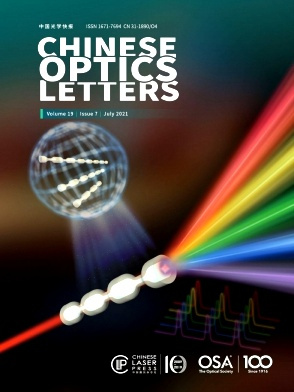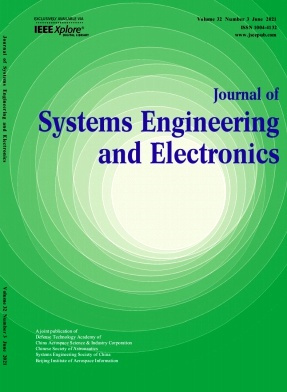
Chinese Optics Letters详细信息
Chinese Optics Letters
Chinese Optics Letters
Chinese Optics Letters投稿要求
Chinese Optics Letters杂志投稿须知:
1、 TitleThe title should be concise but informative. Avoid beginning with an article or a preposition. The words "new" or "novel" should be avoided in the title and the text for legal reasons. Titles may be edited by the publisher to facilitate computer search.。
2、 Author names and AffiliationsAuthor names should be given in full and consistent form to facilitate indexing. Affiliations and postal addresses for all authors should appear on the title page.。
3、 AbstractThe abstract should be no longer than 100 words. It should be informative, without descriptive words or citations, and contain the major conclusions and quantitative results or other significant items in the paper. Together with the title, the abstract must be adequate as an index to all the subjects treated in the paper, and will be used as a base for indexing.。
4、 OCIS CodesOCIS codes should be provided to help with indexing. This set of codes was formulated by the Optical Society of America and well-known in the optical research world. OCIS codes are available on Chinese Optics Letters’ web page and the OSA publication web pages. Each manuscript must be given 2-4 OCIS codes below the abstract, and the principal index code should be placed first.。
5、 EquationsEquations should be punctuated and aligned to bring out their structure, and numbered consecutively in round brackets on the right-hand side of the page.Notation. Notation must be legible, clear, compact, and consistent with standard usage. In general, acronyms should be defined at first use. Variables and Vectors. Set single-letter variables in italics (Eg. M). Set vectors in boldface (Eg. m). Functions, derivative "d," abbreviations, and multi-letter identifiers should be set in roman (plain) type (Eg. α, cos, ∫...dx). Fences. For simple bracketing the usual order of parentheses and brackets is { [ ( { [ ( ) ] } ) ] }. Bit and Byte. The standard abbreviations for bit and byte are b and B, respectively. To avoid confusion, these units should be spelled out in most cases (1 bit, 20 GB). Display equations should be broken and aligned for two-column display unless spanning across two columns is essential. Equations should be centered with equation numbers set flush right. For Math Type math, use the Format Equations feature to format all equations as Times + Symbol 10. Note: There must be a blank line space above and below each displayed equation.。
6、 ReferencesReferences should be numbered consecutively in the order in which they are first referenced in the body of the manuscript. Two references [2,3] should be included together, separated by a comma, and three or more consecutive references should be indicated by the bounding numbers and an en dash [1-4]. When compiling your references, be sure to include the titles of articles. COL requires this information before a paper can be sent to peer review. The reference titles will subsequently be removed by copy editors before they are published, so this information is not included in the length estimate sent to authors when a positive decision is made by the editor. All reference authors should be included in the reference list but when reference authors are mentioned in the text, use surnames only (unless further clarity is needed), and use "et al." and first author name when three or more authors are given. The format of references is as follows:Journal paper1、 Q. Ji, X. Ma, J. Sun, H. Zhang, and Y. Yao, "Novel method for measurement of effective cavity length of DBR fiber", Chin. Opt. Lett. 8, 398 (2010).Book2、 N. Bloembergen, Nonlinear Optics (Springer, 1965).Paper in published conference proceedings3、 R. E. Kalman, "Algebraic aspects of the generalized inverse of a rectangular matrix", in Proceedings of Advanced Seminar on Generalized Inverse and Applications 111 (1976).SPIE proceedings4、 S. K. Griebel, M. Richardson, K. E. Devenport, and H. S. Hinton, "Experimental performance of an ATM-based buffered hyperplane CMOSSEED smart pixel array", Proc. SPIE 3005, 254 (1997).Paper accepted for publication5、 H. Qi, M. Zhu, W. Zhang, K. Yi, H. He, and J. Shao, “Dependence of wavefront errors on the nonuniformity of thin film", Chin. Opt. Lett. (to be published).Internet links6、 A. G. Ramm, H. Wang, and J. Ye, "Invisible obstacles", http://www.arxiv.org/abs/math-ph/0608034 (June 1, 2011).Patent。
7、 K. Zhang, J. Zhang, R. Wang, R. Guo, J. Wang, and K. Peng, “All solid state single frequency and frequency-doubled laser” (in Chinese) Chinese Patent ZL98125474、8 (2000).7、 Figures and TablesFigures should be suitable (resolution above 300 dpi) for immediate reproduction and embedded in the text. They should be set as one column wide (6-8 cm) if possible unless two-column display is essential. In the figures, the main lines should be about 0.3 mm in width, and the assistant lines 0.15 mm. Notations in the figures should be distinct and consistent with the same ones in the text, and their font size will be 7-9 pt. Figures should also be uploaded as separate figure files. Each figure should have its own caption. Color Art is Online Only, and free to authors.Tables must be numbered in order of appearance and identified with appropriate titles. The table title, which should be brief, goes above the table. Note that tables are usually typeset, not scanned (tables cannot be electronically reduced in size). Tables should be set in one column wide if possible and be placed near their first mention in the body.。
8、 Article Length and ProofNote that Chinese Optics Letters has a limit of five printed pages. If a paper exceeds this limit, it must be shortened before the paper is accepted. If the page proof is over the five-page limit, the proof must be shortened before the paper can be assigned to a final issue. Authors should use the COL Word or LaTeX templates to prepare manuscripts to facilitate length checking.
Chinese Optics Letters杂志简介
《Chinese Optics Letters》于2003年创刊,由中国光学学会和中国科学院上海光学精密机械研究所主办,中国激光杂志社出版,美国光学学会全球发行的国际性英文版学术期刊。
《Chinese Optics Letters》自创刊时即坚持走国际化办刊路线,其宗旨是快速、全方位地报道国际光学领域中的最新理论研究、科技成果和创新技术。
《Chinese Optics Letters》目前已被SCI-E、EI、CA、CSA和MSB-S等世界知名检索机构收录。2014年SCI影响因子为1.851。
《Chinese Optics Letters》是我国唯一全面反映激光领域最新成就的英文版专业学报类期刊。主要发表我国在激光、光学、材料应用及激光医学方面卓有成就的科学家的研究论文。
《Chinese Optics Letters》为月刊,每月10号出版。审稿周期约30天,平均发表周期约100天。COL采用OCIS编码对论文进行分类,方便作者、读者查阅。每篇论文都具有DOI号,便于在CrossRef系统中被交叉引用。
Chinese Optics Letters统计分析
影响因子:指该期刊近两年文献的平均被引用率,即该期刊前两年论文在评价当年每篇论文被引用的平均次数
被引半衰期:衡量期刊老化速度快慢的一种指标,指某一期刊论文在某年被引用的全部次数中,较新的一半被引论文刊载的时间跨度
他引率:期刊被他刊引用的次数占该刊总被引次数的比例用以测度某期刊学术交流的广度、专业面的宽窄以及学科的交叉程度
引用半衰期:指某种期刊在某年中所引用的全部参考文献中较新的一半是在最近多少年时段内刊载的
平均引文数:在给定的时间内,期刊篇均参考文献量,用以测度期刊的平均引文水平,考察期刊吸收信息的能力以及科学交流程度的高低
相关推荐
更多热门评论
费了不少功夫,6月底写出了一篇文章,8月初才投Chinese Optics Letters杂志,10月给了修改后录用,提的几点修改意见只是一些小问题,11月10日拿到录用证明,真好。这是本人第一篇核心杂志,真的很高兴。总体感觉Chinese Optics Letters杂志的编辑服务态度很不错,审稿速度挺快的,给个赞!
总的来说速度还算比较快,虽然中间修改的较多,但是只要录用了见刊的速度不是其他杂志能比。Chinese Optics Letters编辑的态度非常好,回复邮件也相当快,经常下班了还修稿,沟通意见。
速度还是很快的,一个月后得到通知让修改继续投,意见特别详细,要求比较高,第一次大修以后投出去,两个月以后回信基本可以了,再修改下就可以了,审稿人特别负责,最后一遍修改的时候,审稿人把我文章里面所有错误的标点符号都修改过来了,特别负责。总体上,8月29号投的,9月30号第一次修改,11月份第二次修改,基本上是接收了,再次修改,次的4月份刊出来。
俗话说一口吃不出一个胖子,但吃成胖子的决心和毅力绝非那些一般人所能理解的,正好赶上投稿网活动,一口气买了一大堆,接下来慢慢体会与鉴赏。物流技术与应用是我一直很青睐的。
Chinese Optics Letters是不错的杂志,投了这个杂志半个多月后录用,审稿老师很认真的,提的意见及建议确实很有价值,后面按老师的要求修改了一回就中了。杂志社的编辑老师态度也很亲和,good job!!杂志挺好的。
Chinese Optics Letters初审及初筛较快,专家很认真负责,每点都帮你挑出来给你怎么修改的提示,修改了2次才录用。将近2个月终审结束,给出审稿意见。审稿费及版面费暂时还没要求收取。
投稿接受后还有多次校稿,Chinese Optics Letters杂志编辑非常仔细,也是很好的学习的过程。因为被拒审三次,拖的时间比较长,问编辑部进展,编辑部很快回信说初步接受,可以给刊用通知,也很快收到了。给个赞!
还是比较不错的的期刊,编辑的效率高,审稿人意见专业、审稿速度快。基本1个月内搞定,从投稿到见刊共需要8个月时间,但是版面费有点贵。。。
感觉和被拒的诸位情形有点像,11月20号左右投了一篇综述,一个月后直接退稿了,建议转投,打电话问了主编,主编说没有送外审,是初审不通过,可是初审不通过可以早点给我通知啊,要一个月之久真是让有点浪费投稿人的时间呀。然后叫我再等一会,过了一会打电话过来跟我说了2个被拒的理由。
该期刊审稿严格,各项工作规范,在线通告系统可实时知道审稿进度,编辑很认真负责,有邮件必回,收到稿件后迅速送审,审稿专家提出的问题也相当有深度,具有专业性。是一个不错的期刊!
常见问题
| Q:论文发表的时候可以一稿多投吗? |
| A:一稿多投的行为是典型的学术不端的行为,是国内外学术界都明令禁止的行为,原因主要在于涉及到文章版权归属的问题,如果作者的文章已经被某个杂志社录用,或者同时被两家杂志社录用,就会涉及到版权纠纷,作为杂志社都会保护本社的合法权益,到这时作者就会比较麻烦,吃官司都是小事儿了,被打入黑名单降级降职影响可就太大了。 |
| Q:职称论文发表对时间有限制吗? |
| A:职称论文发表并没有明确规定截止时间,需要作者结合自己所在地区的具体规定自己安排发表时间,一般职称评审,各地区都会明确规定申报材料的最后期限和截止日期,我们结合这个日期来考虑何时发表文章就可以,大部分地区职称评审都集中在每年的8-10月之间,有的地区要求7月中旬开始交材料,最晚8月底之前,有的则是要求8月中旬交,还有部分地区要求截止时间为申报时间上年的12月31日,所以,各个地区的具体要求并不同,申报者需要在提交材料前确保自己的文章已经见刊并且被相应的数据库检索即可。 |
| Q:网上发表论文如何防骗?可靠网站与可疑网站如何区分? |
| A:由于发表论文的需求远远多于杂志版面的供应,再加上众所周知的审稿难!审稿慢!选择论文发表网站发表表论文确实能解决以上问题。卖方市场的出现加之发表论文的刚性需求,就导致出现先付款后发表的现状。论文发表网站正规与否是通过网站从始至终所提供服务体现出来的,任何交易只要存在时间差都会有风险,但这个风险是可以通过您的智慧来避免的。因为不是所有论文网站都是骗子,你要做的就是过滤掉没保障的网站,选择可靠的论文发表网站! |
| Q:一般期刊需要提前多久准备? |
| A:省级、国家级期刊建议至少提前6个月准备。一般来讲,杂志社为了确保每期杂志正常出刊,都会提前将当期之后1-3个月的稿件提前安排好,而一些创刊较早,认可度更高的热门期刊,来稿量较大,发表周期可能就会更久。提前准备,意味着杂志的可选择性更多。 |
| Q:核心期刊需要提前多久准备? |
| A:核心期刊建议至少提前12个月准备,核心期刊正常的审稿周期为1-3个月,且审核严格,退稿、返修几率更大,这意味着在流程上耗费的时间更久,且核心期刊版面有限,投稿竞争更加激烈,即使被录用,排刊也比普通期刊晚很多,因此需要更早准备。 |

